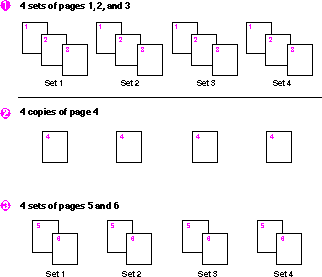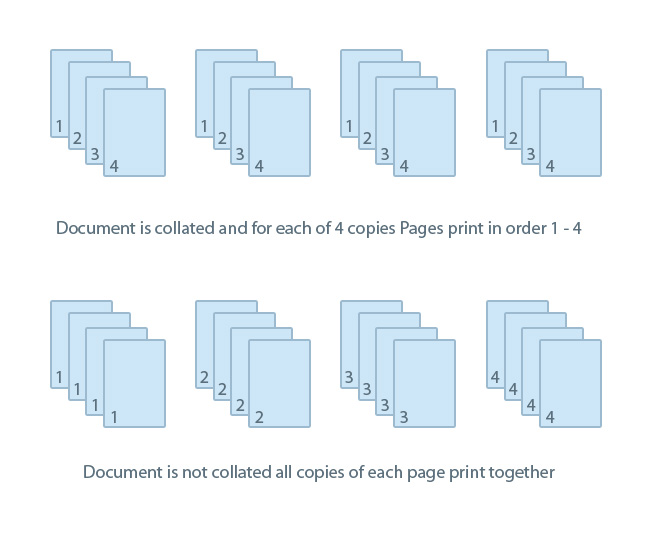


This might seem similar, but the terms are commonly used during discussions on the different specifications of the print job requested. Simply put, your print media will not be put together to make sets. Now that you know what collated copies refer to, uncollated copies refer to the opposite – print media that has copies of the sheets needed separate and not arranged in any order. What Can You Expect from Uncollated and Collated Copies? This will most commonly be used when discussions are in place about preparing manuals, books, catalogs, or collated color copies. So what does collate mean when it comes to printing? When used by a printing service, collating means putting together different sheets of print media or different parts to create a set. However, the meaning changes slightly when used by a printing professional. The list of available collations is usually quite large, due to the fact that each collation can have many different permutations of the above options.Collate is a word that many people have experience with – generally known as a verb to describe collecting, arranging, or assembling items in a specified order. The syntax will depend on your database management system. You should be able to see a list of available collations for your database by running a query. If _VSS is not selected, the collation is variation selector insensitive, and the variation selector is not considered in the comparison. These collations were introduced in SQL Server 2017. If _WS is omitted, then it is width-insensitive, which means that full-width and half-width representations of the same character are considered identical for sorting purposes.ĭistinguishes between various ideographic variation selectors in Japanese collations Japanese_Bushu_Kakusu_140 and Japanese_XJIS_140. If _KS is omitted, then it is kana-insensitive, which means that Hiragana and Katakana characters are considered equal for sorting purposes.ĭistinguishes between full-width and half-width characters. For example, a is equal to ấ.ĭistinguishes between the Japanese kana characters Hiragana and Katakana. For example, a is not equal to ấ.Īccented and unaccented versions of letters are considered identical for sorting purposes. Uppercase and lowercase versions of letters are considered identical for sorting purposes.ĭistinguishes between accented and unaccented characters. Lowercase letters sort ahead of their uppercase versions. So for example, Latin1_General_CI_AS is case-insensitive and accent-sensitive.īelow is a quick overview of the options: Option In SQL Server, collation options are specified by appending the options to the collation name. However, if we change the collation to case-sensitive by using the Latin1_General_CS_AI collation, we get the following result: ArtistId ArtistNameĪs mentioned, case-sensitivity is just one of various options when specifying collation. The options associated with a collation are case sensitivity, accent sensitivity, Kana-sensitivity, width sensitivity, variation-selector-sensitivity.Ĭollations are expressed in different ways, depending on the DBMS that you use.


The above query returns the following result: ArtistId ArtistName Note that this collation has the letters CI, which stands for case-insensitive. In this case, we use the Latin1_General_CI_AI collation. This query uses the ORDER BY clause to order the results, and it uses the COLLATE clause to specify the collation to be used when ordering those results. ORDER BY ArtistName COLLATE Latin1_General_CI_AI Collations can also be specified at the expression level (so you can specify which collation to use when you run a query), and at the identifier level.īelow is a comparison between running a case-sensitive query vs a case-insensitive query in SQL Server. Depending on the DBMS, collation can be specified at the server level, the database level, the table level, and the column level. Collation can also be used to distinguish between various ideographic variation selectors in certain collations (such as the Japanese_Bushu_Kakusu_140 and Japanese_XJIS_140 collations that were introduced in SQL Server 2017).ĭifferent database management systems will provide different collation options. Collation provides the sorting rules, case, and accent sensitivity properties for the data in the database.įor example, when you run a query using the ORDER BY clause, collation determines whether or not uppercase letters and lowercase letters are treated the same.Ĭollation is also used to determine how accents are treated, as well as character width and Japanese kana characters. In database systems, Collation specifies how data is sorted and compared in a database.


 0 kommentar(er)
0 kommentar(er)
